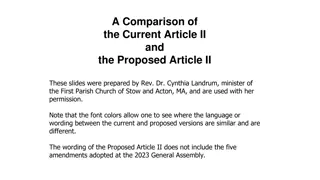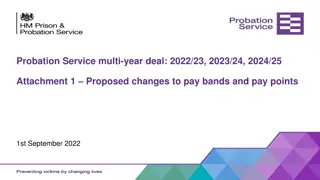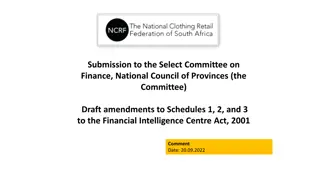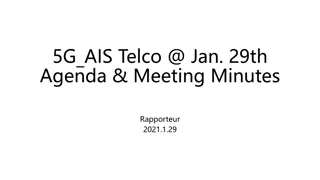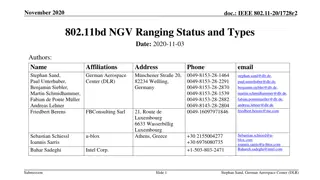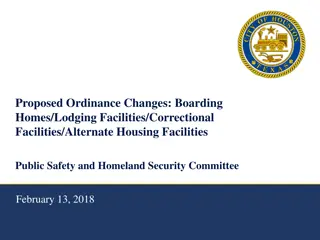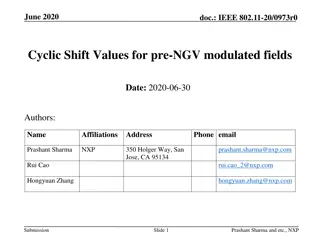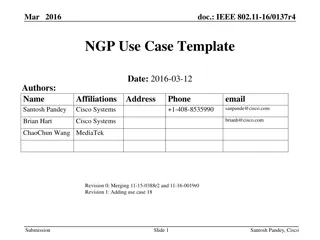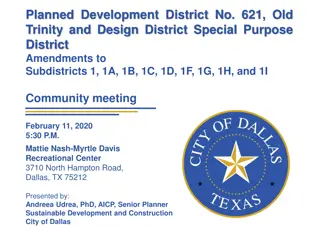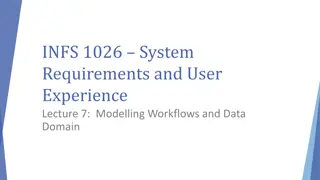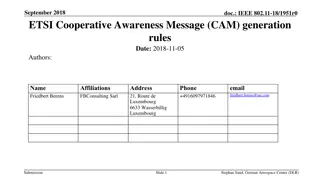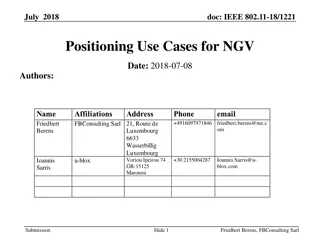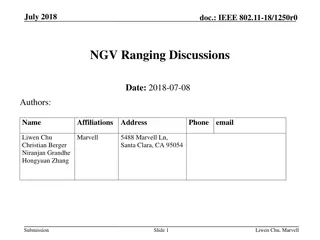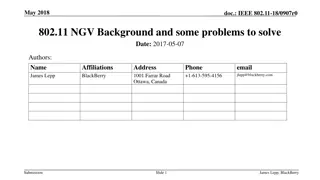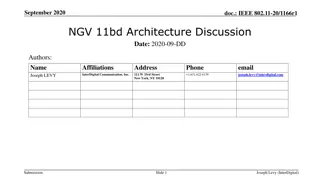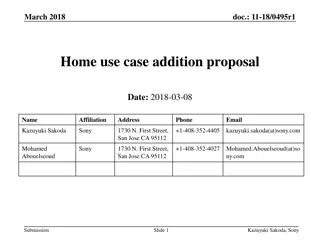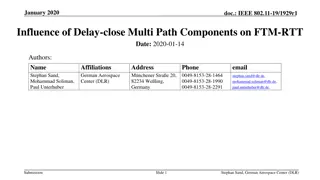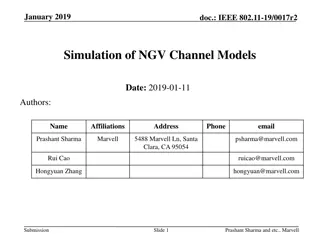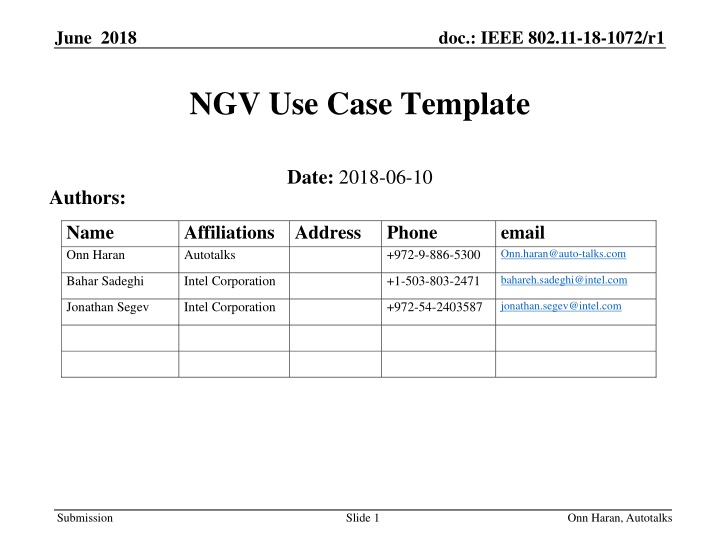
IEEE 802.11 NGV Use Case Template Overview
Explore the proposed template for describing NGV use cases, aiming to derive clear requirements for automotive organizations like C2C-CC, CAMP, and SAE. Topics include terminology, basic safety messages, sensor sharing, and multi-channel operation.
Download Presentation

Please find below an Image/Link to download the presentation.
The content on the website is provided AS IS for your information and personal use only. It may not be sold, licensed, or shared on other websites without obtaining consent from the author. If you encounter any issues during the download, it is possible that the publisher has removed the file from their server.
You are allowed to download the files provided on this website for personal or commercial use, subject to the condition that they are used lawfully. All files are the property of their respective owners.
The content on the website is provided AS IS for your information and personal use only. It may not be sold, licensed, or shared on other websites without obtaining consent from the author.
E N D
Presentation Transcript
June 2018 doc.: IEEE 802.11-18-1072/r1 NGV Use Case Template Date: 2018-06-10 Authors: Name Onn Haran Affiliations Address Autotalks Phone +972-9-886-5300 email Onn.haran@auto-talks.com bahareh.sadeghi@intel.com Bahar Sadeghi Intel Corporation +1-503-803-2471 jonathan.segev@intel.com Jonathan Segev Intel Corporation +972-54-2403587 Submission Slide 1 Onn Haran, Autotalks
June 2018 doc.: IEEE 802.11-18-1072/r1 Abstract This document is a proposed template to describe use cases for NGV The use cases should be reviewed by the relevant Automotive organizations, specifically with Car-2-Car Communication Consortium (C2C-CC), Crash Avoidance Metrics Partnership (CAMP) and SAE The goal is to derive a clear set of requirements from the use cases Submission Slide 2 Onn Haran, Autotalks
June 2018 doc.: IEEE 802.11-18-1072/r1 Terminology Backward Compatible Ability to decode IEEE802.11p messages, and transmitting messages decoded by IEEE802.11p devices Co-existence Ability of IEEE802.11p devices not to transmit while non- IEEE802.11p messages are transmitted Submission Slide 3 Onn Haran, Autotalks
June 2018 doc.: IEEE 802.11-18-1072/r1 1. Basic Safety Messages (BSM) Overview: Allvehicles periodically (typ. 10HZ) broadcast a message containing its basic information. Based on received messages, driver is alerted of an upcoming safety risk Channel 172 is used in US. Channel 180 is used in EU Deployment timeline: IEEE802.11p solutions are deployed now, with de-facto solutions to missing requirements. Enhanced range solution are likely to be adopted by the market once available Requirements: Antenna diversity Up to 500km/h relative speed operation It is desired to increase IEEE802.11p range. NHTSA DSRC NPRM defines 300m minimal communication range, which is hard to satisfy in urban NLOS. Target would be 25% length increase over IEEE802.11p in this case Limitations: Full backward compatibility, able to decode and understand messages of 11p Maintaining channel load Maintaining fairness Submission Slide 4 Onn Haran, Autotalks
June 2018 doc.: IEEE 802.11-18-1072/r1 2. Sensor Sharing Overview: Vehicles periodically broadcast all detected objects from all sensors, and receive objects from all other vehicles Sensor sharing message is under definition. Actual packet length is TBD, but expected to be much longer than BSM because many objects can be detected by many sensors The channel is yet to be determined Deployment timeline: >2023 (expected) Requirements: Number of transmitted bytes per packet is higher (>50%) than IEEE802.11p under same conditions (duration, PER, range, wireless channel) for maintaining transmission time as current IEEE802.11p BSM Limitations: Submission Slide 5 Onn Haran, Autotalks
June 2018 doc.: IEEE 802.11-18-1072/r1 3. Multi-Channel Operation Overview: Concurrent multi-channel operation, where one channel is safety channel, and the second is non-safety Deployment timeline: Now (most pilot deployments); >2023 (OEMs installations expected) Requirements: High availability of safety channel Minimal same-vehicle cross-interference blinding self-vehicle safety channel by non-safety channel transmissions Minimal cross-vehicles interference blinding near-vehicle from receiving a safety message coming from a far vehicle High utilization of all channels Limitations: Submission Slide 6 Onn Haran, Autotalks
June 2018 doc.: IEEE 802.11-18-1072/r1 4. Infrastructure Applications Overview: Safety and non-safety data from infrastructure to vehicles Deployment timeline: Now Requirements: High throughput Limitations: Existing applications should maintain backward compatibility IEEE802.11p vehicles may be capable to upgrade to support new applications Submission Slide 7 Onn Haran, Autotalks
June 2018 doc.: IEEE 802.11-18-1072/r1 5. Vehicular Positioning Overview: Radar technology is not always accurate, reflective surfaces may not be the most rear ones e.g. motorbikes, e-bikes, pedestrian holding a smartphone. Measure accurate distance to other road-users based on known antenna position, either in same or different lanes or to pedestrians on roadside or crosswalk. Requirements: 0.3m LoS accuracy, 10Hz typical refresh rate, unassociated operation. With or without orientation. V2V, V2I and V2P operation, with variable refresh rate. Limitations: Higher accuracy is normally achieved via larger bandwidth which allow higher channel resolutions. Submission Slide 8 Onn Haran, Autotalks
June 2018 doc.: IEEE 802.11-18-1072/r1 6. Vehicular Location Overview: Drivers would like to get guidance to a parking spot at a building or underground parking lot. GPS reception is either non-existent or inaccurate (>10m accuracy). Urban canyon scenario, get turn by turn guidance at city centers. Requirements: 1-2m NLoS positioning accuracy, 10hz refresh rate. Limitations: Submission Slide 9 Onn Haran, Autotalks
June 2018 doc.: IEEE 802.11-18-1072/r1 Requirements Summary Backward compatible mode Antenna diversity Up to 500km/h relative speed operation Longer range (nice to have) Potential non-backward compatible mode High throughput High channel utilization Migration to backward compatible mode Multi-channel operation High availability of safety channel High utilization of all channels Submission Slide 10 Onn Haran, Autotalks
June 2018 doc.: IEEE 802.11-18-1072/r1 References Submission Slide 11 Onn Haran, Autotalks


